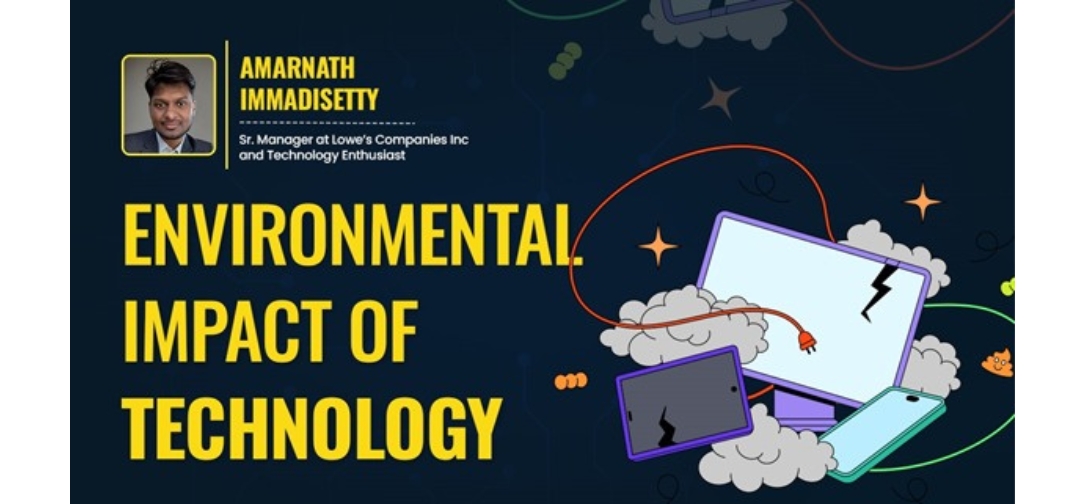New Delhi [India], February 17: The rapid advancement of technology has transformed nearly every aspect of our daily lives, from how we communicate to how we work and consume goods. While these innovations have brought significant benefits, they have also raised pressing concerns about their environmental impact. As we continue to integrate technology into our lives, understanding its effects on the environment is essential for fostering sustainable practices and mitigating negative consequences. This article explores the multifaceted relationship between technology and the environment, examining both the detrimental effects and potential solutions.
The Dual Nature of Technology
Positive Contributions
Technology has the potential to address various environmental challenges. Innovations in renewable energy, waste management, and conservation efforts demonstrate technology’s capacity to promote sustainability. For instance:
- Renewable Energy Technologies: Solar panels and wind turbines harness natural resources to produce clean energy, reducing reliance on fossil fuels and lowering greenhouse gas emissions.
- Smart Agriculture: Precision farming technologies optimize resource use, minimize waste, and enhance crop yields while reducing environmental impacts.
- Environmental Monitoring: Advanced sensors and data analytics enable real-time monitoring of air quality, water resources, and biodiversity, facilitating informed decision-making for conservation efforts.
Negative Consequences
Despite these positive contributions, technology also poses significant threats to the environment. The following sections explore some of the primary negative impacts associated with technological advancements.
- Resource Depletion
Mineral Extraction
The production of electronic devices requires a vast array of minerals and metals, many of which are finite resources. The extraction processes can lead to habitat destruction, soil degradation, and water pollution.
Example: The mining of rare earth elements used in smartphones and electric vehicles often involves environmentally harmful practices that result in significant ecological damage.
Energy Consumption
The energy required to power data centers, manufacturing facilities, and electronic devices contributes to increased carbon emissions. As demand for technology grows, so does the energy consumption associated with it.
Example: Data centers that support cloud computing services consume substantial amounts of electricity. According to a report by the International Energy Agency (IEA), data centers accounted for about 1% of global electricity demand in 2020.
- Electronic Waste (E-Waste)
The Growing E-Waste Problem
As technology evolves rapidly, electronic devices become obsolete at an alarming rate. This leads to a significant increase in electronic waste (e-waste), which poses serious environmental hazards.
Toxic Materials: Many electronic devices contain hazardous substances such as lead, mercury, and cadmium. When improperly disposed of, these materials can leach into soil and groundwater, contaminating ecosystems.
Recycling Challenges
While recycling programs exist for e-waste, many devices still end up in landfills due to improper disposal practices or lack of awareness. Effective recycling requires specialized processes that can recover valuable materials while minimizing environmental harm.
Example: A study by the United Nations University estimated that only 17% of e-waste was recycled properly in 2019, leading to millions of tons of toxic waste entering landfills.
- Air Pollution
Emissions from Technology Production
The manufacturing processes for electronic devices often involve the release of harmful pollutants into the atmosphere. These emissions contribute to air quality degradation and pose health risks to nearby communities.
Example: Factories producing smartphones may emit volatile organic compounds (VOCs) and particulate matter during production processes, impacting air quality locally.
Transportation Emissions
The logistics involved in transporting technological products also contribute to carbon emissions. Shipping devices across long distances requires significant fuel consumption and generates greenhouse gases.
Example: The global supply chain for electronics involves extensive transportation networks that contribute to air pollution and climate change.
- Water Pollution
Contamination from Manufacturing Processes
The production of technology often involves chemical processes that can result in water pollution. Wastewater generated during manufacturing may contain toxic substances that contaminate local water sources if not properly treated.
Example: Semiconductor manufacturing produces wastewater containing heavy metals and acids that can harm aquatic ecosystems if released untreated into rivers or lakes.
E-Waste Leachate
Improper disposal of e-waste can lead to leachate formation—liquid that drains or ‘leaches’ from a landfill containing hazardous materials. This leachate can contaminate groundwater supplies.
Example: Landfills containing discarded electronics may allow toxic substances to seep into surrounding soil and water sources over time.
- Climate Change Impacts
Greenhouse Gas Emissions
The energy consumption associated with technology contributes significantly to greenhouse gas emissions. As more devices are connected through the Internet of Things (IoT) and cloud computing becomes ubiquitous, energy demands will continue to rise.
Example: Cryptocurrency mining operations consume vast amounts of electricity—often derived from fossil fuels—resulting in substantial carbon footprints that exacerbate climate change.
Feedback Loops
The relationship between technology use and climate change can create feedback loops where increased energy consumption leads to higher emissions, further accelerating global warming effects such as extreme weather events.
Strategies for Mitigating Environmental Impact
- Sustainable Design Practices
Encouraging manufacturers to adopt sustainable design practices can reduce resource consumption and e-waste generation. This includes designing products for longevity, repairability, and recyclability.
Example: Companies like Fairphone prioritize modular designs that allow users to easily replace components rather than discarding entire devices.
- Energy Efficiency Initiatives
Promoting energy-efficient technologies can help mitigate the environmental impact associated with high energy consumption. This includes investing in renewable energy sources for powering data centers and manufacturing facilities.
Example: Google has committed to operating its data centers on renewable energy sources, significantly reducing its carbon footprint over time.
- E-Waste Recycling Programs
Implementing comprehensive e-waste recycling programs can help divert hazardous materials from landfills while recovering valuable resources. Public awareness campaigns can educate consumers about proper disposal methods.
Example: Best Buy operates a nationwide recycling program that allows customers to drop off old electronics at their stores for responsible recycling.
- Policy Advocacy
Advocating for policies that promote sustainability within the tech industry is essential for driving systemic change. Governments can implement regulations mandating responsible e-waste management practices or incentivizing companies adopting sustainable technologies.
Conclusion: The impact of technology on the environment presents both challenges and opportunities for innovation towards sustainability. Understanding how various aspects—such as resource depletion, e-waste generation, air pollution, water contamination, and greenhouse gas emissions—interact with technological advancements is vital for developing effective strategies that mitigate harm while harnessing benefits effectively.
By prioritizing sustainable design practices alongside energy efficiency initiatives—and advocating for responsible policies—organizations can navigate this complex landscape responsibly while contributing positively toward preserving our planet’s health for future generations.
About Amarnath Immadisetty:
Amarnath Immadisetty is a seasoned technology leader with over 17 years of experience in software engineering. Currently serving as the Senior Manager of Software Engineering at Lowe’s, he oversees a team of more than 20 engineers.
Amarnath is known for driving transformation through innovative solutions in customer data platforms, software development, and large-scale data analytics, significantly enhancing business performance.
Throughout his career, Amarnath has held key positions at notable companies such as Target, Uniqlo, and CMC Limited. His strong foundation in technical leadership and engineering excellence enables him to foster innovation in data-driven decision-making. Passionate about mentoring the next generation of engineers, Amarnath actively promotes diversity and inclusion within the tech industry, believing that diverse teams lead to better innovation and problem-solving.
For more updates visit his website https://immadisetty.me

































